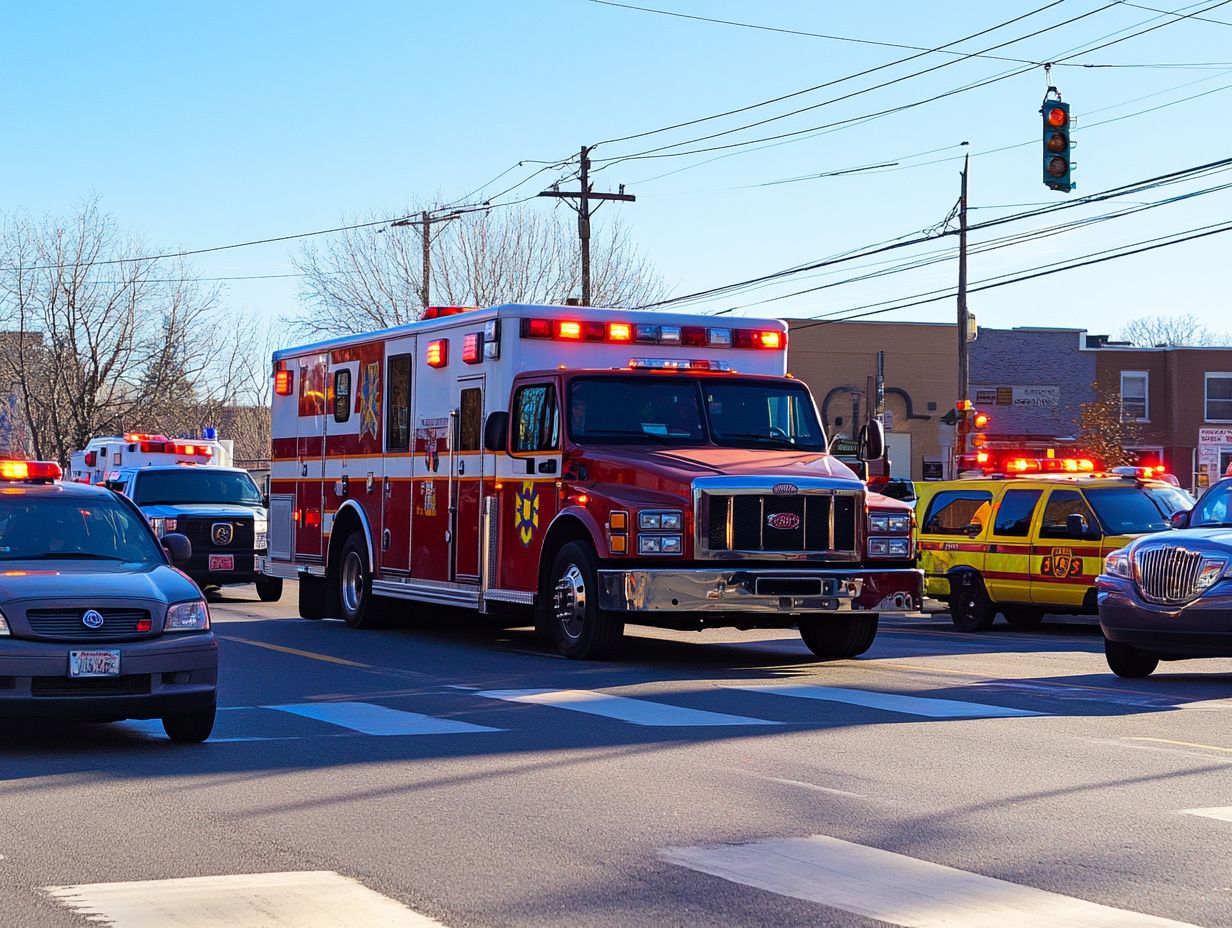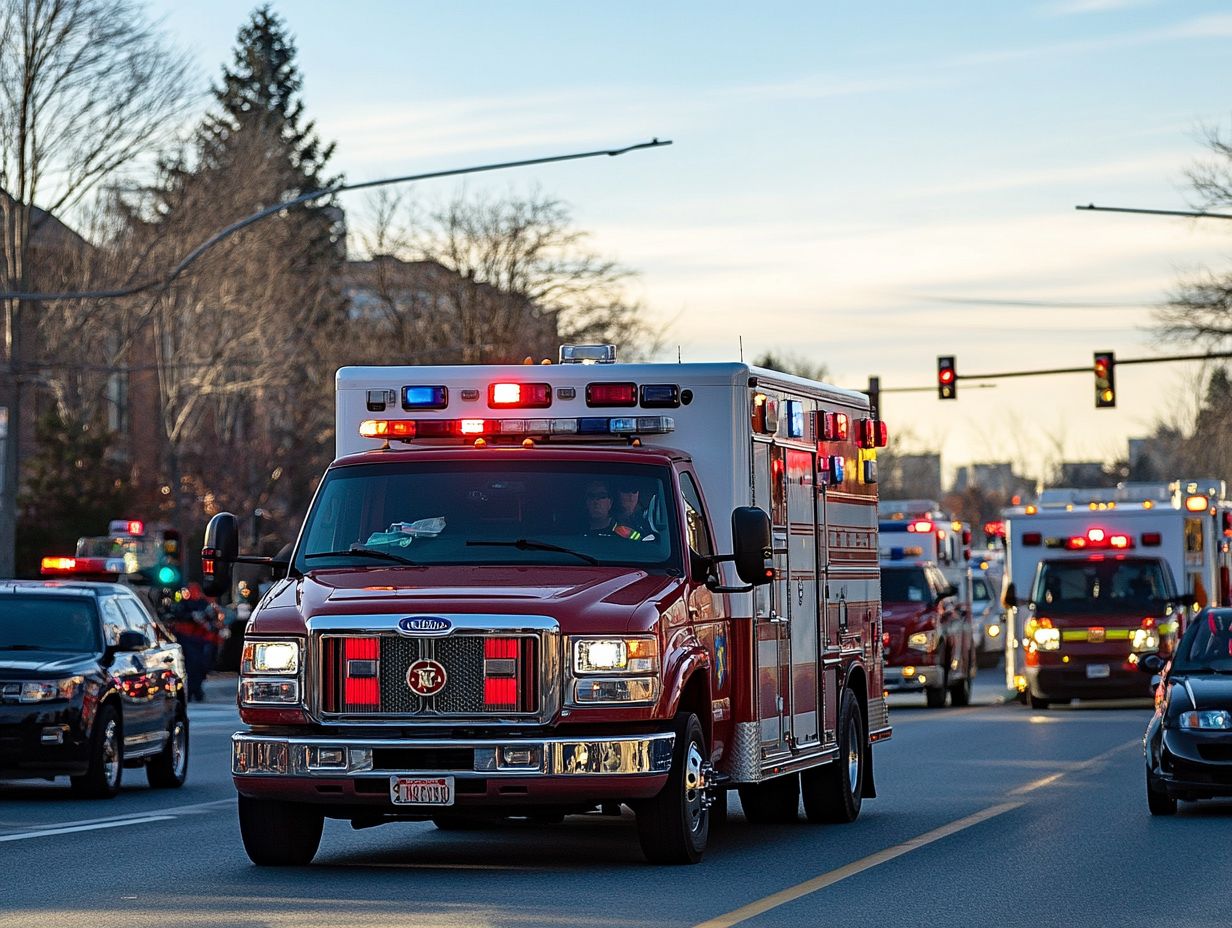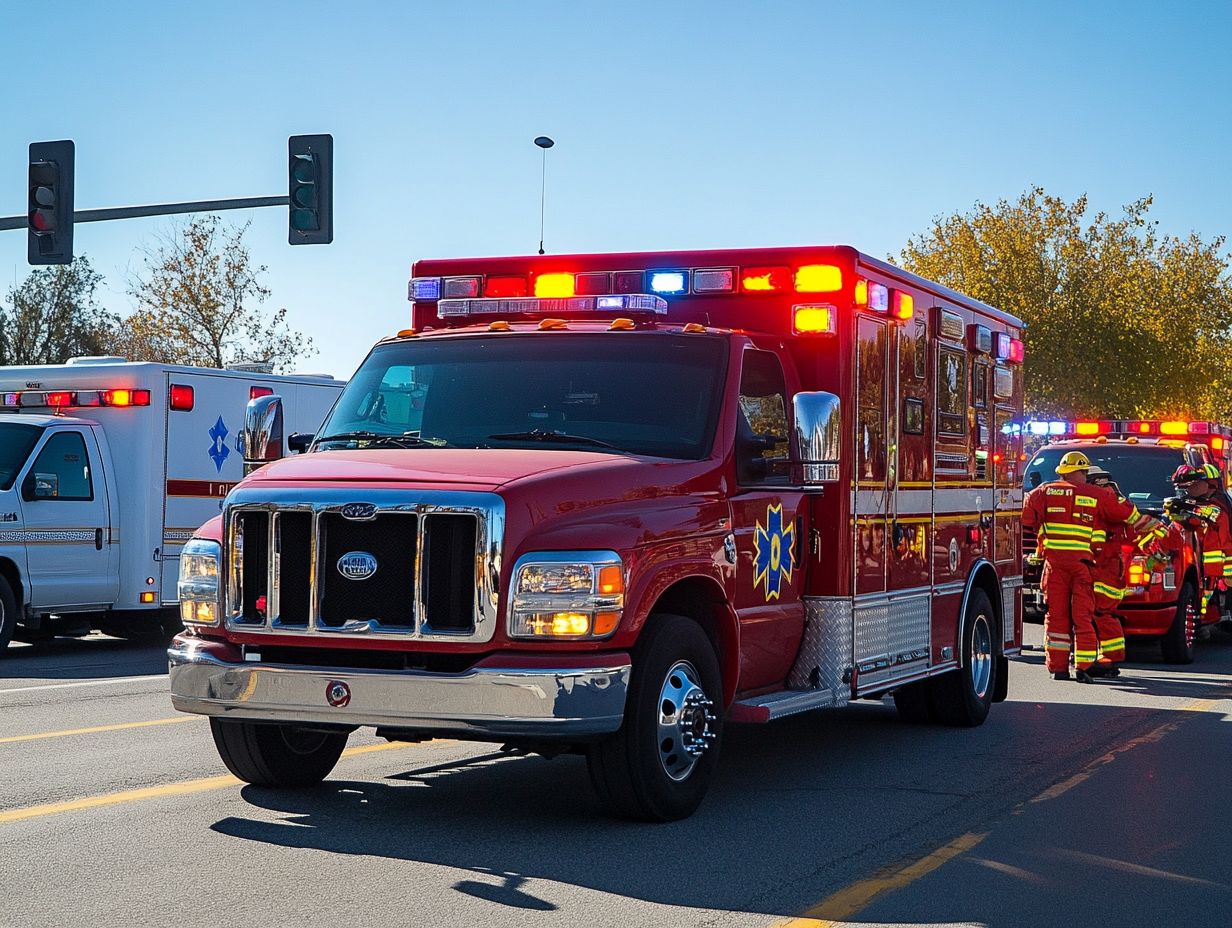What is Coverage for Emergency Response Vehicles?
Emergency response vehicles are essential to public safety and health. They are expertly equipped to handle urgent situations that demand immediate attention.
These vehicles think ambulances, fire trucks, and various specialized emergency units are urgently designed to provide rapid assistance during crises.
It’s crucial for you to grasp their definitions, types, and coverage, especially if you’re involved in emergency services. This article delves into the various kinds of emergency vehicles, such as ambulances, fire trucks, and police cars, while also shedding light on the coverage options available for these essential assets.
You will discover the significance of proper coverage, the factors that influence it, and the benefits and potential pitfalls of being adequately insured. Join in as these pivotal aspects are unpacked, illustrating how effective emergency response can be significantly enhanced through a thorough understanding of coverage.
Contents
- Key Takeaways:
- Understanding Emergency Response Vehicles
- Types of Emergency Response Vehicles
- Coverage for Emergency Response Vehicles
- Importance of Proper Coverage
- Factors Affecting Coverage
- Frequently Asked Questions
- What is Coverage for Emergency Response Vehicles?
- What does Insurance for Emergency Response Vehicles include?
- Why is Insurance for Emergency Response Vehicles important?
- Is Insurance for Emergency Response Vehicles mandatory?
- How is Insurance for Emergency Response Vehicles different from regular auto insurance?
- Do all emergency response vehicles have the same insurance coverage?
Key Takeaways:

- Coverage for emergency response vehicles includes protection for damages, liability, and medical expenses incurred during emergencies.
- Proper coverage for emergency response vehicles is crucial to ensure quick and efficient response to emergencies and to avoid financial burden on emergency service providers.
- The location, type of vehicle, and services provided are important factors that affect the coverage and insurance rates for emergency response vehicles.
Understanding Emergency Response Vehicles
Emergency response vehicles are purposefully crafted to tackle emergencies and deliver vital services to the public.
These vehicles ambulances, fire trucks, and police cars are equipped with the essential tools and resources necessary to manage urgent situations with precision and effectiveness. Their function transcends simple transportation; they play a pivotal role in saving lives, reducing damage, and safeguarding public safety during crises.
In your community, seeing these vehicles makes citizens feel safer and more secure, highlighting the significance of a well-functioning emergency response system.
The public sector auto insurance is crucial for protecting both the vehicles and the dedicated personnel who operate them, providing various coverage options designed to address the unique challenges faced by emergency services.
Types of Emergency Response Vehicles
Emergency response vehicles are designed in a variety of forms, each meticulously engineered for distinct emergency scenarios. These vehicles are outfitted with specialized tools and advanced technologies, ensuring they can effectively support you in times of crisis.
Ambulances, Fire Trucks, and Police Cars

Ambulances, fire trucks, and police cars stand out as the most recognizable emergency response vehicles, each fulfilling a unique role in the intricate tapestry of emergency management.
Ambulances are outfitted with cutting-edge medical equipment, enabling trained paramedics to deliver immediate care when it matters most.
Fire trucks, meanwhile, are equipped with specialized tools, including hoses and ladders, designed to combat fires and rescue individuals trapped in perilous situations.
Police cars, in contrast, come fitted with advanced communication systems and protective gear, enabling officers to respond swiftly to incidents and uphold public safety. Collectively, these vehicles create a vital network for effective crisis response.
Each type is backed by tailored insurance options that address their specific needs, ensuring they remain ready and capable of springing into action when lives hang in the balance.
Coverage for Emergency Response Vehicles
Coverage for emergency response vehicles is essential. It safeguards your organization against unforeseen costs like towing fees and liability claims that may arise during operations, including coverage for fire trucks.
By securing this protection, you ensure that your team can focus on their critical mission without the burden of unexpected financial surprises.
What it Includes and How it Works
Your insurance coverage for emergency response vehicles should typically include the following:
- Protection against legal claims
- Physical damage coverage
- Emergency road service
These components are key to maintaining seamless operations.
They are essential for sustaining the readiness and reliability of services that save lives, such as ambulances, fire trucks, and police vehicles.
Protection against legal claims acts as your safety net against legal claims arising from accidents involving these specialized vehicles. Physical damage coverage shields you from losses due to accidents or vandalism.
Emergency road service is also important, allowing your vehicles to quickly get back into action after minor incidents.
Evaluate your insurance options today to ensure your team is protected when it matters most. Insufficient coverage can lead to severe operational disruptions at critical times.
Importance of Proper Coverage
Ensuring proper coverage for emergency response vehicles is crucial. It not only secures the financial stability of your organization but also enhances the quality of emergency services delivered to the community.
Benefits and Consequences

Securing proper insurance for emergency response vehicles is essential for your organization’s success! The repercussions of lacking such coverage can be dire.
When emergency responders are equipped with comprehensive insurance, they gain financial protection against unexpected expenses tied to accidents, equipment damage, or legal liabilities.
This coverage offers peace of mind, allowing responders to concentrate on their vital duties and ensuring continuity of operations in case of an incident.
On the flip side, insufficient coverage can lead to overwhelming financial strain, jeopardizing the ability to deliver essential services and potentially putting lives at risk.
In a field where every second counts, ensuring that vehicles are adequately insured is not merely a legal obligation; it s a strategic necessity.
Factors Affecting Coverage
Numerous factors influence the coverage options available for emergency response vehicles. To better understand your options, it’s important to explore what is coverage for personal vehicles. Consider the following:
- Type of vehicle
- Operational location
- Specific services provided by your organization
Each of these elements plays a critical role in determining the most suitable coverage for your needs.
Location, Type of Vehicle, and Services Provided
The location, type of vehicle, and services you provide are crucial factors that insurers consider when determining coverage for utility vehicles.
For example, if your emergency service organization operates in a bustling urban environment, you may face higher premiums compared to a counterpart in a rural area. This is due to increased traffic and a greater likelihood of accidents.
The type of vehicle you use significantly impacts your coverage. Specialized apparatus like ambulances or fire trucks often demand more extensive coverage due to their unique operational risks, leading to higher costs.
The range of services you offer also affects coverage. Whether it s advanced life support or hazardous material response, specific coverage limitations can influence your overall insurance options.
Thoroughly evaluate your organization’s needs and budget before making decisions.
Frequently Asked Questions
Welcome to the FAQs section! Here, you’ll learn more about coverage for fleet vehicles, including emergency response vehicles.
What is Coverage for Emergency Response Vehicles?

Coverage for Emergency Response Vehicles refers to the insurance provided to vehicles used for emergency response and rescue purposes. This includes ambulances, fire trucks, police cars, and other emergency vehicles, as well as coverage for event vehicles.
What does Insurance for Emergency Response Vehicles include?
Insurance for Emergency Response Vehicles typically includes coverage for specialized vehicles such as accidents, damage, and equipment on board.
It may also cover injuries to employees and volunteers who operate the vehicle.
Why is Insurance for Emergency Response Vehicles important?
Having the right insurance for emergency response vehicles is essential for safeguarding your team and resources!
In the event of an accident or damage, it protects your organization from financial loss.
Is Insurance for Emergency Response Vehicles mandatory?
Yes, in most cases.
Many states require these vehicles to have a specific level of insurance to operate on public roads.
Most organizations also require full insurance for accidents and damage.
How is Insurance for Emergency Response Vehicles different from regular auto insurance?
This insurance often includes special coverage for equipment unique to emergency vehicles.
It also has higher liability limits and options tailored to the unique risks these vehicles face.
Do all emergency response vehicles have the same insurance coverage?
No, the insurance varies based on the type of vehicle and its use.
For example, the coverage for an ambulance differs from that of a fire truck.
It’s vital to work with an insurance provider who understands your organization’s specific needs.






